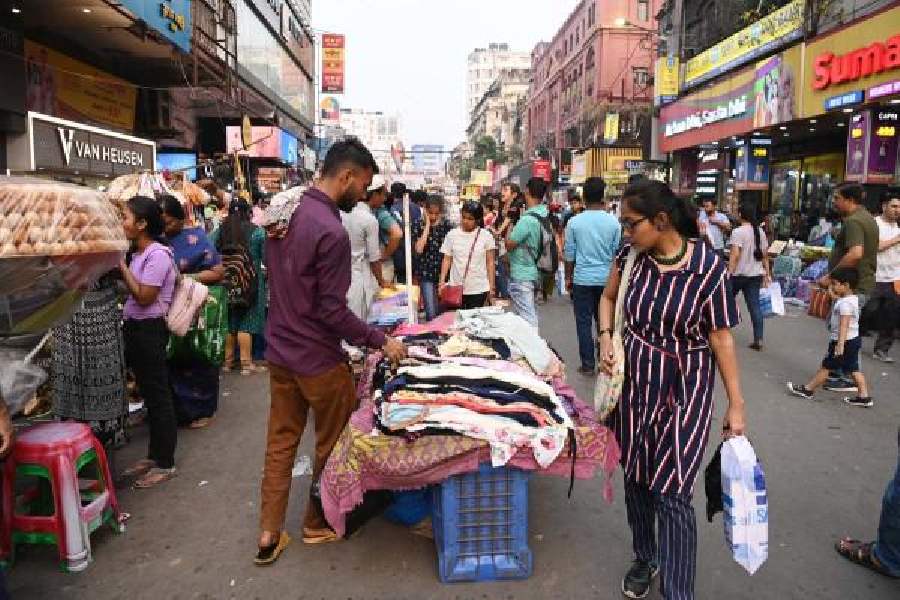Hawkers have returned to their old ways in Gariahat and not budged in the New Market area.
With elections round the corner, not much is going to change in the next few months either, admitted members of the city’s town vending committee and officials of the Kolkata Municipal Corporation (KMC).
Stalls occupying more than half the width of pavements and encroaching on roads, in violation of street vending rules framed by the state government, are common in the Gariahat area.
In January 2023, the KMC had allowed hawkers in Gariahat to build overhead tin shades that did not extend beyond one-third width of the pavements.
A yellow line was drawn on the pavements to mark the space where hawkers can set up stalls. The rest — beyond the one-third width — has to be kept free for pedestrians, as stipulated by the street vending rules.
The vendors adhered to the rules initially, but over the months they went back to their old ways.
The situation is far worse in the New Market area, where the hawkers have ignored all directives from the KMC to abide by the vending rules.
The civic body and the police had drawn yellow lines on pavements along roads in the New Market area to demarcate space for hawkers.
The vendors, however, continue to occupy more than the allotted space. And on Humayun Place and Bertram Street, they have even set up stalls on the carriageway and are refusing to budge.
The state government had framed the street vending rules — West Bengal Urban Street Vendors (Protection of Livelihood and Regulation of Street Vending) Rules — in 2018.
The rules were framed after the Street Vendors (Protection of Livelihood and Regulation of Street Vending) Act, 2014, a central law, came into force.
The act and the rules aim to strike a balance between the rights of hawkers and that of pedestrians.
The reality, though, is different. Street vendors still violate rules with impunity, leaving little space for pedestrians.
The town vending committee, which is the sole authority under the 2014 act to regulate hawkers, last met on March 12.
Members of the committee told The Telegraph that they are unlikely to meet again at least in the next couple of months because of the upcoming Lok Sabha elections.
Kolkata South and Kolkata North, as well as Jadavpur (parts of which are under the KMC), will go to the polls on June 1. The results will be announced on June 4, more than two months from now.
“We are aware that hawkers in the New Market area are violating the one-third rule. We have to again put pressure on them to make them fall in line. The police’s help may be needed to draw the yellow lines again. But over the next several weeks the police will remain busy with election-related work,” said Debashis Das, a hawker leader and member of the town vending committee.
Officials in the KMC, who spoke on condition of anonymity, too said any measures aimed at forcing hawkers to follow rules are unlikely before the elections.
“It seems unlikely that there will be any attempt to force the hawkers to adhere to the rules in the run-up to the polls,” said a KMC official.
On Sunday, this newspaper spotted four stalls near the Gariahat crossing that were facing the road, a violation of a condition set by the town vending committee, according to a KMC official.
One of them, a tea stall, was right next to the Gariahat-Rashbehari autorickshaw stand, another was in front of Traders Assembly and the other two stalls were on the stretch of Gariahat Road leading to Golpark.
“If a stall faces a road, customers have to stand on the carriageway. That is risky,” said an official.
On a stretch near Anandamela, hawkers have set up stalls on either side of a pavement, leaving a narrow passage in between for pedestrians.
The stalls on the two sides together took up more than two-thirds width of the
pavement.
